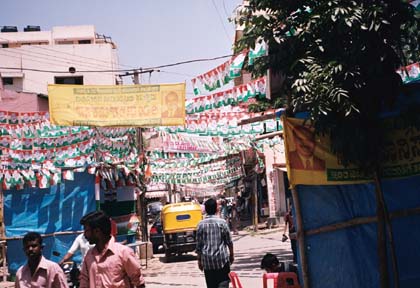|
|
Maria's Corner: Late April 2004 |
Bangalore, India
posted 2 May 04
We’re about 4 months into it, and life has returned to normal. We know our way around - at least for the most part - we know where to shop, we found a couple of good restaurants and we are starting to make some friends. True, nothing about our life here may seem normal at first glance: much has been written, not least by Ted, about the traffic, the pollution, the noise, and also the self-centeredness of many Indians (how different is that from the US, really?). Just step out of the house and you’ll see a million things that take some getting used to – starting from the way people look, move and dress, to the multitude of exotic vehicles on the road (including the improbable and endless combination of goods that can be carried on them), to the narrow lanes crowded with vendors selling everything from vegetables to rugs to ironing services on wooden hand carts. From the trees that are growing in the most unlikely places, with cement or tar coming right up to the trunk, and that are flowering in the most brilliant purples, yellows and reds depending on the “season” (more on that some other time). To the chickens and the rooster that live down the street and that I was proud to finally have spotted one day – the faint echo of the morning cockadoodledo ringing in my ears as I saw them, more dream than reality. To the women who are nonchalantly walking around in their night gowns, all cut the same way, floor length and with a frilly semi circle from shoulder to shoulder, in groups of two or three, chatting away. But yes, there is normalcy in all of that. In fact, I remember surprising myself after just a few weeks when I realized how easy and completely normal all this seemed to the eye when we stepped out of our hotel onto the street.
Life in India is lived on the street. Some of these things I had been told over the months prior to our departure have come back to me as clues at various moments. Our understanding is continually expanding, of course, so what is a clue today may be thrown out as a wrong conclusion tomorrow. But I have noticed this a lot: we see things day in and day out and may not wonder about them, but some day a light bulb goes off, apparently for no reason other than some chemical reaction in the brain that connects the proverbial dots. It could be a simple thing like the “Use Me” stickers on all the trash cans at work. They all have swinging lids so initially I thought this was to indicate that one needs to push down on one end to get to the opening. It took me a while to realize this was simply about not throwing the trash next to the bin which is a commonplace occurrence everywhere else. Which brings us back to the street. Trash is a huge problem. There are piles of it everywhere. Or maybe I should say, it is a perfectly normal sight, and a logical outcome of 1 billion people in a space about one third of that of the US (we hear this a lot: 1 billion people. It is used to explain everything from the irrational behaviour of drivers on the road to the poverty and beggars on the street to the corruption of government officials). Trash may be burnt in open sewage canals at night, sorted through by cows and dogs for organic elements, or manually swept up into wide flat wicker baskets and then loaded onto open trucks, loose, to be carted off to God-knows-where. All of this with an assembly line of people, of course.
I suppose all this reads a little different from Ted’s missive. I have been “heavy with labor” on this article for a while. But in reality, it won’t be much of an article, it’ll be series of impressions, shot through with my personal reflections and conclusions about the things we encounter here. Let Ted be the reporter, I’ll be the diarist. To me, it’s in the little things, it’s the moments of beauty and perfection – the images are different here, the sights, the sounds, the colors, and there are plenty of things which simply don’t seem to make sense. But let them be recorded, or at least noticed, like the carpet of little white and purple flowers that the first rain had knocked off the trees that day I just couldn’t find a riksha to take me home and decided to walk. And while I haven’t met a Guru or found enlightenment either, India does offer plenty of feasts for the eyes, the ears and the palate. So, stay tuned for more.
|


